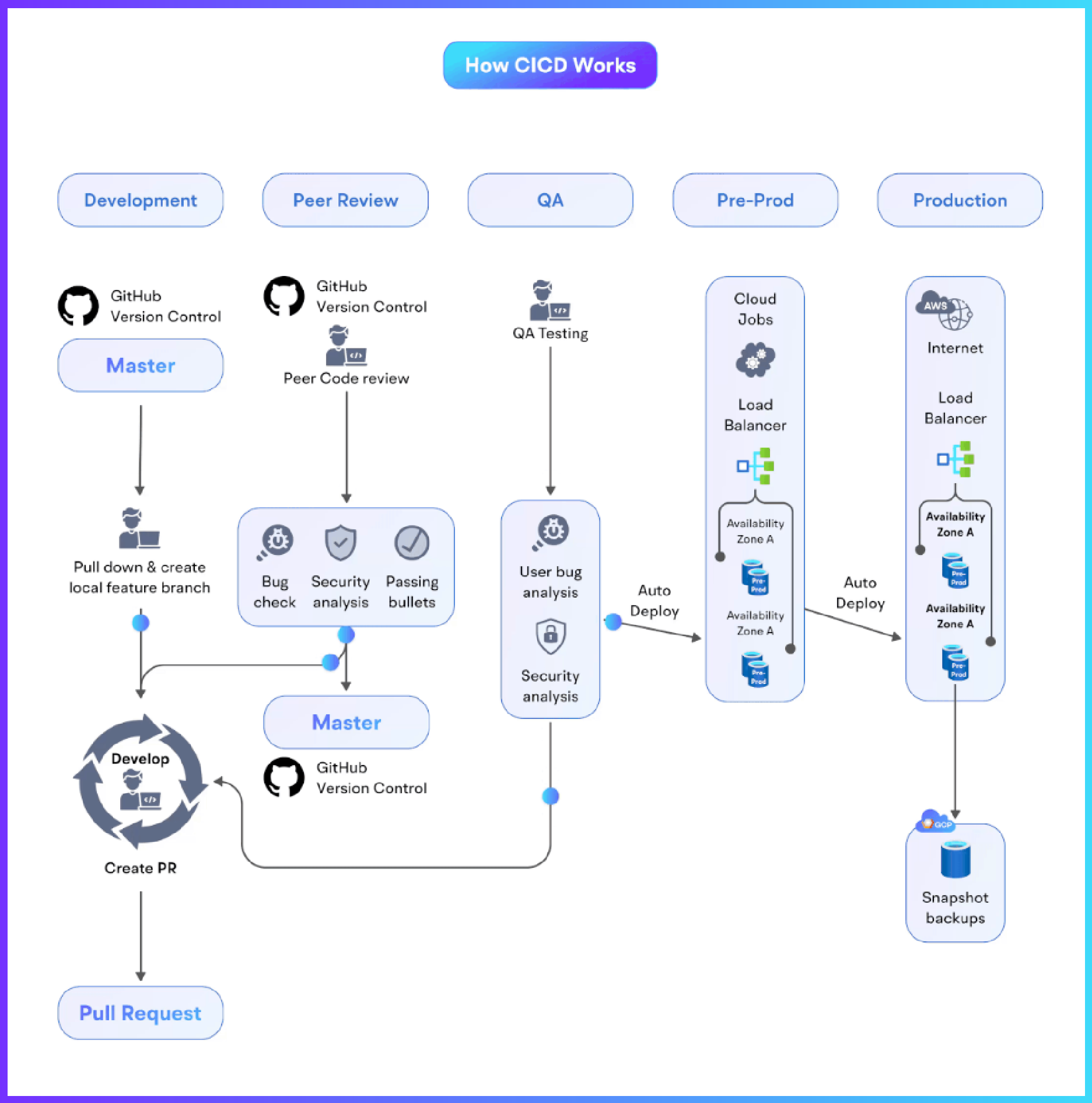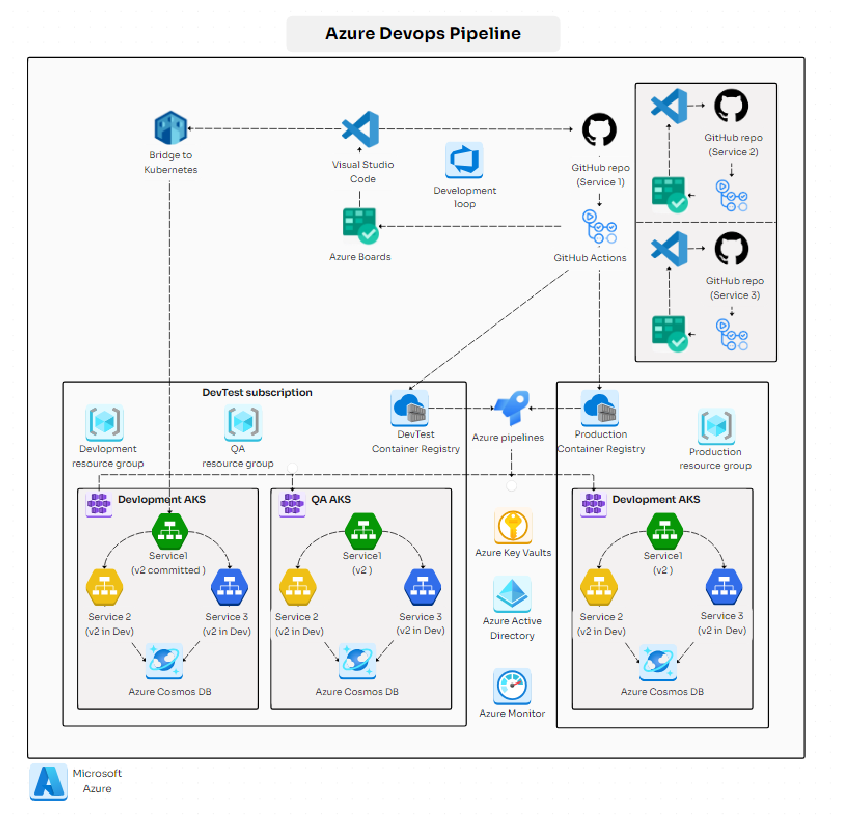Home » How to Build CI/CD Pipeline with the Azure DevOps ?


This ensures that consumers will receive the new features rapidly and reliably
Get free Consultation and let us know your project idea to turn into an amazing digital product.
 In today’s fast-paced software scene, having a CI/CD (Continuous Integration/Continuous Deployment) pipeline is essential for getting software out the door quickly and smoothly. This pipeline has three main stages: build, test, and deploy, and each plays a vital role.
In today’s fast-paced software scene, having a CI/CD (Continuous Integration/Continuous Deployment) pipeline is essential for getting software out the door quickly and smoothly. This pipeline has three main stages: build, test, and deploy, and each plays a vital role.

Modern software development requires continuous integration and continuous deployment (CI/CD) pipelines because they automate the processes of developing, testing, and delivering code changes. The software development lifecycle can be streamlined by building CI/CD pipelines with Azure DevOps’ strong platform. This comprehensive tutorial guides you through the process of creating Azure DevOps CI/CD pipelines.
Integrating Azure DevOps Boards for mobile app development brings a new dimension to your software delivery pipeline. You can remotely monitor and control your CI/CD pipelines, including Azure DevOps boards, when using the Azure DevOps mobile app . This tool gives developers and project members fast insights by providing real-time updates on build statuses, deployment progress, and overall pipeline health, including the status of tasks and work items managed through Azure DevOps Boards. With the Azure DevOps mobile app, you can remain up to date on your development projects, including Azure DevOps Boards, from anywhere at any time, which promotes agility and teamwork throughout the mobile app development process.
Pipelines for continuous integration and continuous deployment, or CI/CD, are essential to contemporary software development because they expedite the creation, testing, and delivery of code changes. When implementing CI/CD pipelines in Azure DevOps, adhering to best practices becomes significant for achieving efficient, secure, and reliable software delivery. We’ll examine some best practices in this section to help businesses optimize their CI/CD workflows in the Azure DevOps environment.
Implementing Infrastructure as Code (IaC) tools is foundational for maintaining consistency and automating infrastructure provisioning. This practice ensures that your infrastructure is defined and deployed in a repeatable and version-controlled manner.
Automation is the foundation of continuous integration and continuous delivery, or CI/CD. Due to automated deployment techniques, software upgrades are deployed smoothly and without errors. This guarantees the timely and dependable delivery of releases while also improving the efficiency of your development pipeline.
Adopting continuous integration practices involves the automated initiation of build and test processes immediately after code changes are committed. This proactive feedback mechanism facilitates swift identification and resolution of issues, thereby enhancing the stability and reliability of the codebase.
Utilize a resilient version control system like Git for the purpose of overseeing and tracing code modifications. This approach fosters collaborative efforts, establishes a comprehensive historical log of alterations, and enforces a methodical approach to managing the codebase.
Establishing a clear branching strategy is essential for managing concurrent development efforts, bug fixes, and releases effectively. This practice ensures a structured codebase, minimizing conflicts and streamlining the release process.
Implement automated testing at various levels, including unit, integration, and end-to-end tests. Automated testing not only ensures code quality but also expedites the identification and resolution of bugs, contributing to a more reliable application.
Incorporate robust monitoring and observability practices into your CI/CD pipeline using tools like Azure Monitor and Application Insights. This ensures real-time insights into application performance, availability, and user experience.
Incorporate security checks seamlessly within your CI/CD pipeline by leveraging tools such as Azure Security Center. Early identification and mitigation of security risks during the development phase are imperative to ensure the delivery of software that is both secure and resilient.
Leverage collaboration tools such as Azure Boards, Teams, and Confluence to enhance communication and visibility within development teams. Effective collaboration fosters a more cohesive and productive development environment.
Regularly assess your CI/CD pipeline configurations to guarantee they align with the dynamic project requirements and adhere to industry best practices. The process of optimization should be continuous, as it plays a pivotal role in enhancing the efficiency and effectiveness of your software delivery pipeline over time.
Azure DevOps is a comprehensive platform that optimizes the software development lifecycle, and it is built around the capabilities of CI/CD pipelines. These pipelines eliminate human error and facilitate a trustworthy, efficient deployment process by automating the integration and delivery of code updates. Azure DevOps CI/CD pipelines make it simple for developers to create, test, and launch applications in a variety of environments that support a broad range of technologies. Benefits from automated testing include reduced error rates, improved teamwork, faster time to market, and higher-quality software. The platform can be linked with popular cloud providers such as Google Cloud, AWS, Azure, and Azure DevOps Server due to its flexibility. This gives businesses a solid base on which to build their CI/CD workflows, which in turn guarantees effective and superior software delivery.
INDIA : F-190, Phase 8B, Industrial Area, Sector 74,
Mohali, India
CANADA : 55 Village Center Place, Suite 307 Bldg 4287, Mississauga ON L4Z 1V9, Canada
USA :2598 E Sunrise Blvd, Fort Lauderdale,FL 33304,
United States

Founder and CEO

Chief Sales Officer
